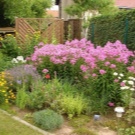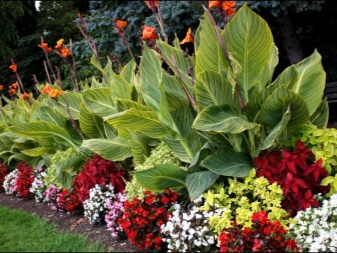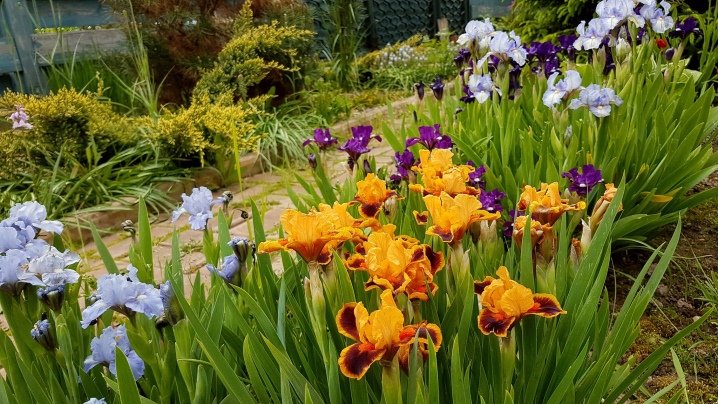Unpretentious and long-flowering perennial garden flowers

There are quite a few unpretentious long-flowering perennial plants, which in their beauty and aroma are not inferior to the pampered varieties of garden flowers, but they do not require painstaking care. They are surprisingly in harmony with other colors in all-season compositions, they form a good landscape design and look great in a single version. Some varieties begin to bloom as soon as the snow cover melts, while others flaunt until late autumn, until the snow covers them. Let's talk about the most popular and unpretentious long-blooming perennial garden flowers among summer residents.

Peculiarities
Perennials are plants that do not need to be planted annually. Their underground tubers, bulbs and rhizomes can overwinter in the ground and sprout with fresh shoots in spring. Many of them reproduce by underground parts of the mother plant, and some by self-seeding (using seeds). Unpretentious perennials are highly rated by gardeners for their undeniable benefits:
- reproduce easily even without human intervention;
- have a long flowering period;
- unpretentious in care;
- frost-resistant;
- do not require renovation and transplantation up to 10 years;
- with their help, you can create a perennial flower bed that does not require constant replanting of plants;
- have a large selection, there is an unprecedented multitude of perennial varieties.




The disadvantages of perennial plants include diseases of their underground parts, which are more common than in annuals. In addition, the creation of a flower bed will require certain investments and several years of waiting. Perennial flowers are good because they do not need to be planted and replanted every year, they can take care of themselves. The main thing is to initially place them correctly so that you do not have to transplant.
Perennials are very diverse, some love light, others shade, each has different preferences in soil and moisture. All this should be considered before planting a plant. Perennials are short, tall and of mixed type, some grow in wide bushes, others in single inflorescences.
When creating a flower bed, plants are planted so that they do not interfere with each other. For example, tall flowers will create shade, which means that shade-loving ones can be planted nearby. Perennial plants bloom at different times and bloom for a long time. When creating a flower bed, these terms should be taken into account so that it does not remain empty for a long time.






Species overview
Perennials delight us from early spring to late autumn, surprise with a variety of forms and a rich palette. You can classify them in different ways, in our review we divided them by size.
Tall
These include irises, peonies, delphiniums. They always occupy a central place in the flower bed, making it possible to place smaller plants in their field of vision. Arches are framed with tall flowers, hedges are created from them, unsightly buildings and fences are hidden behind them. Terraces, gazebos and pergolas are decorated with tall plants.




Astilba
A tall flower of the Stonefragment family, there are up to 20 varieties. Grows wild in North America and East Asia. Astilba is not afraid of frost, loves moisture, it can be planted in flooded swampy areas, it feels good in the shade. Blooms profusely, with wonderful bright brushes. This is a summer plant, its size and flowering time depend on the variety. Juicy inflorescences astilbe pleases in different periods of summer, the earliest species bloom in early June, the late ones - at the end of August. Astilba has dwarf varieties that form bushes about 30 cm, and there are also tall ones, reaching 1.5 meters in height. The easiest way to propagate it is by dividing the bush, but a seed option is also possible. The plant is afraid of drought and needs frequent watering.
When planting in the shade, do not get too close to the root system of large trees, they will compete for moisture. For the rest, astilba is easily combined with moisture-loving flowers and perfectly complements the flower beds of the garden.

Delphinium
Forms pyramidal dense inflorescences, directed upwards, up to 60 cm in size. The range of colors is varied, but blue shades prevail. Depending on the species, the delphinium blooms in different periods of summer, delighting with variegated flower beds for about a month. It is necessary to cut off the wilted pyramids, then after 30-40 days it can repeat flowering. If you correctly make a flower bed of different varieties, it will not stop blooming from early June to September, surprising with a variety of colors. Dwarf varieties are only 30 cm in size, and tall species can create hedges about 2 meters high. The more fertile the soil, the larger the delphinium. It reproduces by dividing the bush and seeds. It should be planted in a sunny place with a weak shade.

Stock-rose
Belongs to the Malvovs, grows in the wild in North Africa, reaches a size of 2 meters. She hides old garden fences well, creates hedges. The flowers of the stock rose are double or semi-double, the tonality is very different. From the beginning of June, the plant begins to release fluffy inflorescences attached to the peduncle, right on the thick stem. Flowering occurs gradually, from the bottom up, some flowers die off, others appear, everything continues for a long time. The stock-rose begins to bloom in the second year of life, but in a warm summer it can please with buds in the first year. Preparing for winter, the plant is cut, leaving stems no more than 40 cm.

Irises
Today, about 800 species of this genus are known. Dwarf varieties grow up to 30 cm, but most irises are much taller, some reach 1.5 meters in height. The plant blooms from May to July, it all depends on the climatic conditions it grows in, the warmer the climate, the earlier it blooms. Irises can grow on any soil and winter well. For 7 years, they can not be transplanted.

Peonies
Lush, surprisingly beautiful, unpretentious perennial, whose growth often reaches 2 meters. Peonies are undemanding to the soil, they tolerate frost well. They can stay in one place without a transplant for up to 20 years. Spherical large flowers have a variety of colors. Depending on the variety, plants can be dwarf, medium or tall. They grow in bushes, creating beautiful thickets of greenery and inflorescences of delicate shades. Some species have a noticeable pleasant aroma, but there are varieties that are odorless. Peonies are most often used for monoclumbus.

Medium-sized
These include most types of garden plants. In flower beds, they occupy the second tier, grow in neat small bushes or separate flowers about 30-40 cm high. These are ideal plants for summer cottages, landscaping parks and private estates.




Tulips
The most famous and common bulbous plants of the Liliaceae family. They number up to 150 wild species, which became the progenitors of many thousands of varieties of garden tulips. Virtually any soil is suitable for them, they tolerate winters well. Tulips bloom in spring, opening buds on erect stems that can be 10 to 90 cm in height, depending on the variety. Breeders delight us with a wide variety of these wonderful flowers, their petals are double, simple with a smooth surface or with wavy edges. The range of colors is endless - white, black, multi-colored, with stripes, blotches and unusual patterns. Flowers fully open during the day and close at night. The active mass growth of the plant occurs from the beginning of April, and after 3 weeks the buds appear. In stable, cool weather, tulips bloom for 15-20 days. In gardens, they are often planted as colored groups on a green lawn.

Dicenter
Represents the Dymyankov family, has about 20 species. Herbaceous unpretentious perennial grows naturally in China, the Far East and North America. It is a shrub with a height of 30 to 60 cm. Dicenter has a deep branched rhizome, in one place it can grow up to 8 years. Its long stalks are covered with pink or white flowers, shaped like a heart. The plant blooms in May and pleases with its beautiful appearance for a whole month. It goes well with medium-sized spring plants - daffodils, tulips, hyacinths.

Geranium (pelargonium)
The flower is so beautiful that people prefer to grow it at home, but in the summer it feels great outdoors too. The inflorescences are endowed with a variety of colors, they can be both simple and terry, some varieties look like compact bunches of roses. Geranium takes root well in the southern regions of the country, in other territories in winter it is better to transfer it indoors.

Day-lily
In the wild, the flower can be found in Europe and Asia, it grows in height from 30 cm to a meter, long fan-shaped leaves can reach a length of 120 cm. The flowers are large in the form of lilies, with a large number of shades. They form beautiful bushes that designers love to use in the arrangement of gardens. In one place, a plant can grow up to 15 years.

Undersized
These include plants whose height does not exceed 30 cm. They are erect and creeping. Most spring flowers are small in size. In summer, the vegetation tends to rise, but there are still plenty of compact species. They are good for decorating alpine slides, carpet flower beds, flower bed edging, curbs are made of low flowers. Often, low-growing plants are used as a background, filling the voids between medium-sized flowers.




Gypsophila
They form a low, but wide, airy bush, with many small flowers of lilac, white, lavender color, behind which leaves are almost invisible. Gypsophila is often used to form bridal bouquets filled with grace, air and light. The plant forms more than 100 varieties. It loves the sun, loose soil, but feels great on soil with limestone deposits. Gypsophila is used as an addition to large-flowered species.

Muscari
The perennial belongs to the Asparagus family, it has more than 60 species. Grows on forest edges, mountain slopes of Europe and Asia Minor. Plant height is 10-25 cm, depending on the species. Inflorescences look like pyramids on dense stems, each flower separately looks like a tiny bell. Muscari are most often found in blue, white and light blue, their spring bloom lasts 3-4 weeks.

Crocuses (saffron)
A tiny plant 8-15 cm tall, the first to emerge from under the snow cover. From March to May, you can see cute bright crocus flowers in a forest, park or garden. The plant has more than 80 species, on the basis of which about 300 varieties have been bred. Saffron loves bright sunny glades or partial shade. In landscape design, they are used to decorate rocky hills and lawn beds. The bulbs are transplanted during the freezing period of the ground part, in August - September.

Periwinkle
An unpretentious creeping perennial of the Kutrov family. In the wild, it grows in Europe and Southeast Asia. Long, creeping stems can take root wherever the knot and soil come into contact.The leaves have a rich dark green tone, the flowers are most often found blue, blue or purple. Mass flowering occurs in the spring. In the future, until winter, the soil will be covered with a green cover of a creeping plant, with a rare manifestation of residual flowering.

Pushkinia
Long-flowering bulbous perennial of the Asparagus family, found naturally in the mountains of the Caucasus and Iran. Flowers are collected in racemose inflorescences from 7 to 17 pieces each. Blooms in April - May (depending on the climate) and keeps flowering for 15-20 days. This small flower has an incredibly delicate pleasant scent. Alpine hills, rockeries are planted with Pushkinia, used as curbs along the paths. They are often planted with other spring flowers.

Care Tips
In order not to complicate the care of perennials, you need to study at the planting stage which soil a particular plant prefers, its requirements for lighting, moisture, proximity to other flowers, and find the right place for each species in your garden.
- Shade-loving ones include: fern, periwinkle, fragrant violet, lily of the valley, anemone, daylilies, hydrangea, fuchsia, rhododendrons.
- Prefer sunlight: irises, tulips, daffodils, crocuses, primroses, peonies, bells, lilies, dahlias, chrysanthemums, gladioli, phloxes, clematis.
- They love moisture: wild rosemary, loosestrife, many types of geraniums, irises, astilba, primrose.
- They do not tolerate an abundance of water: anaphalis, gypsophila, pearl mussel, lavender, helipterum, cornflowers, amaranth.

When planting a flower bed with perennials, flowers are selected not only taking into account their size and color, but also with their climate preferences and all of the above.
Such a flower garden can please up to 10 years without a transplant and special care. It is only necessary to remove the faded dried specimens in time and water the moisture-loving varieties.
The most unpretentious perennials will be those species that are adapted to the area, which means that they can be found not only in the garden, but also in the neighboring wild meadow.

Examples in landscape design
It should be understood that a planted perennial can grow in one place for up to 10-12 years, and it is better if this place is thought out initially. We offer you to see examples of mesmerizing gardens formed according to all the rules of landscape design with the participation of perennials.
- Tall peonies are in perfect harmony with low shrubs, organizing a cozy garden corner.

- Slender bushes of blue iris coexist with pink geraniums.

- A variety of varieties of asters allows you to make amazing flower beds out of them.

- The spring flower garden is incredibly beautiful, the combination of daffodils with pansies is marked by a riot of colors.

- Tulips and daffodils are wonderful materials for decorating a park area.

- An exquisite flower bed with hyacinths.

- Delphinium participates in the creation of a multi-tiered flower garden.


- A beautiful three-level irregularly shaped flower bed. For the lower tier, periwinkle and pansies were chosen, for the middle tier - tulips, for the upper tier - a birch tree.

Gardeners always use unpretentious long-flowering perennials to decorate their site. From year to year, everything blooms and pleases around, but you don't need to make any efforts for this, the free time can be spent on rest in a blooming garden.
For unpretentious perennials blooming all summer, see the next video.







































































































The comment was sent successfully.